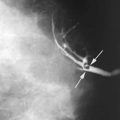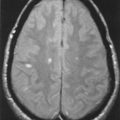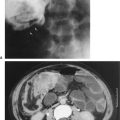In this chapter, a short overview of head and neck imaging is presented. With the recent advancement and widening availability of sectional imagings, such as computed tomography (CT) and magnetic resonance imaging (MRI), the part played by the plain radiographs has decreased significantly.
As an initial screening of sinusitis or facial trauma, radiographs may be used when more sophisticated sectional imagings are not readily available. For facial bone and paranasal sinus evaluation, routine radiographic views include Waters (Fig. 8.1), Caldwell (Fig. 8.2) and lateral (Fig. 8.3) views. Lack of aeration in the sinus antra is suggestive of sinusitis, and a definitive diagnosis can be made when an air–fluid level is present. CT is the primary modality for the evaluation of sinus infection and facial trauma (Figs. 8.4 to 8.6), because bone detail is best evaluated by CT. Because of multiple horizontally placed buttresses of the facial skeleton, multiplaner reconstructed images in coronal and sagittal planes generated from axial data are essential for the detailed evaluation of facial fractures (Figs. 8.7 to 8.9).
MRI is the modality of choice for the evaluation of neoplastic lesions of the head and neck because of its superior soft-tissue characterization and multiplaner capability. MRI is essential to evaluate skull base involvement by head and neck tumors.
Clinical presentation of pain, swelling over the paranasal sinuses, and leukocytosis are sufficient for the diagnosis of sinusitis; and, in the majority of cases, imaging is not necessary. When intraorbital or intracranial extension of the inflammatory process is suspected and surgical intervention is contemplated, imaging becomes necessary. CT is the modality of choice. Acute fluid collection in the sinus cavity is diagnostic, and associated findings include mucosal thickening (Fig. 8.10) and erosive or destructive changes of the sinus wall. Extension of the inflammatory process into the orbits (Fig. 8.11) or cranial cavity may be seen and help determine the therapeutic approach.
For examination of children, the developmental sequence of the paranasal sinus should be taken into consideration. Generally, the ethmoid and maxillary sinuses are present at birth but may not be aerated. The sphenoid and frontal sinuses start to be seen at about 3 and 6 years of age, respectively.
For the evaluation for facial fractures, CT is also the modality of choice. Nasal fractures are the most common, followed by zygomatic fractures. Zygomatic fractures commonly involve (a) the lateral orbital wall at the frontozygomatic suture, (b) the maxillozygomatic suture, and (c) the zygomatic arch, and is named a “trimalar” or “tripod” fracture (Fig. 8.12). If the facial fracture extends posteriorly and violates the pterygoid plate, the fractured facial bones are detached from the cranium. Depending upon the level of the fracture line traversing the central midface, these fractures are classified as Le Fort I, II, or III fractures (Figs. 8.13 and 8.14).
CT is essential to evaluate the entrapped soft tissue and nerves by the fracture fragments, which may require urgent decompression.
Orbital blowout fracture occurs when an object larger than the orbit, such as a fist or a baseball, hits the eye. The impact is transmitted to the orbital contents and raises the intraorbital pressure enough to shatter the weakest wall of the orbit, either the inferior wall into the maxillary sinus (Fig. 8.15) or the medial wall (lamina papyracea) into the ethmoid sinus, without fracturing the orbital rim. The inferior rectus muscle may be trapped and cause paralysis of the inferior gaze of the affected eye.
Premature fusion of a cranial suture (craniosynostoses) prevents growth of cranium in direction perpendicular to the involved suture. Sagittal synostosis results in a narrow, long head (dolichocephaly, scaphocephaly). Bilateral coronal or lambdoid synostosis results in a broad short head (brachycephaly). Unilateral coronal or lambdoid synostosis results in an asymmetric head (plagiocephaly). CT with three-dimensional reconstruction is useful for evaluation of coexisting intracranial abnormalities and surgical planning (Fig. 8.16).
Stay updated, free articles. Join our Telegram channel

Full access? Get Clinical Tree








